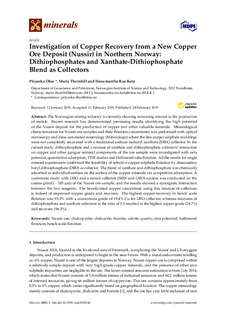| dc.contributor.author | Dhar, Priyanka | |
| dc.contributor.author | Thornhill, Maria | |
| dc.contributor.author | Kota, Hanumantha Rao | |
| dc.date.accessioned | 2019-09-24T06:17:13Z | |
| dc.date.available | 2019-09-24T06:17:13Z | |
| dc.date.created | 2019-02-28T12:34:04Z | |
| dc.date.issued | 2019 | |
| dc.identifier.citation | Minerals. 2019, 9 (3), . | nb_NO |
| dc.identifier.issn | 2075-163X | |
| dc.identifier.uri | http://hdl.handle.net/11250/2618325 | |
| dc.description.abstract | he Norwegian mining industry is currently showing increasing interest in the production of metals. Recent research has demonstrated promising results identifying the high potential of the Nussir deposit for the production of copper and other valuable minerals. Mineralogical characterization for Nussir ore samples and their flotation concentrates was performed with optical microscopy and Zeiss automated mineralogy (Mineralogic) where the fine copper sulphide middlings were not completely recovered with a traditional sodium isobutyl xanthate (SIBX) collector. In the current study, dithiophosphate and a mixture of xanthate and dithiophosphate collectors’ interaction on copper and other gangue mineral components of the ore sample were investigated with zeta potential, quantitative adsorption, FTIR studies and Hallimond tube flotation. All the results for single mineral experiments confirmed the feasibility of selective copper sulphide flotation by disecondary butyl dithiophosphate (DBD) as collector. The blend of xanthate and dithiophosphate was chemically adsorbed as individual entities on the surface of the copper minerals via competitive adsorption. A systematic study with DBD and a mixed collector (SIBX and DBD) system was conducted on the coarse grind (−105 µm) of the Nussir ore sample, and the results showed a synergistic interaction between the two reagents. The beneficiated copper concentrate using this mixture of collectors is indeed of improved copper grade and recovery. The highest copper recovery in bench scale flotation was 95.3% with a concentrate grade of 19.4% Cu for DBD collector, whereas mixtures of dithiophosphate and xanthate collectors in the ratio of 3:1 resulted in the highest copper grade (24.7%) and recovery (96.3%). | nb_NO |
| dc.language.iso | eng | nb_NO |
| dc.publisher | MDPI | nb_NO |
| dc.rights | Navngivelse 4.0 Internasjonal | * |
| dc.rights.uri | http://creativecommons.org/licenses/by/4.0/deed.no | * |
| dc.title | Investigation of Copper Recovery from a New Copper Ore Deposit (Nussir) in Northern Norway: Dithiophosphates and Xanthate-Dithiophosphate Blend as Collectors | nb_NO |
| dc.type | Journal article | nb_NO |
| dc.type | Peer reviewed | nb_NO |
| dc.description.version | publishedVersion | nb_NO |
| dc.source.pagenumber | 23 | nb_NO |
| dc.source.volume | 9 | nb_NO |
| dc.source.journal | Minerals | nb_NO |
| dc.source.issue | 3 | nb_NO |
| dc.identifier.doi | 10.3390/min9030146 | |
| dc.identifier.cristin | 1681328 | |
| dc.description.localcode | © 2019 by the authors. Licensee MDPI, Basel, Switzerland. This article is an open access article distributed under the terms and conditions of the Creative Commons Attribution (CC BY) license (http://creativecommons.org/licenses/by/4.0/). | nb_NO |
| cristin.unitcode | 194,64,90,0 | |
| cristin.unitname | Institutt for geovitenskap og petroleum | |
| cristin.ispublished | true | |
| cristin.fulltext | original | |
| cristin.qualitycode | 1 | |

